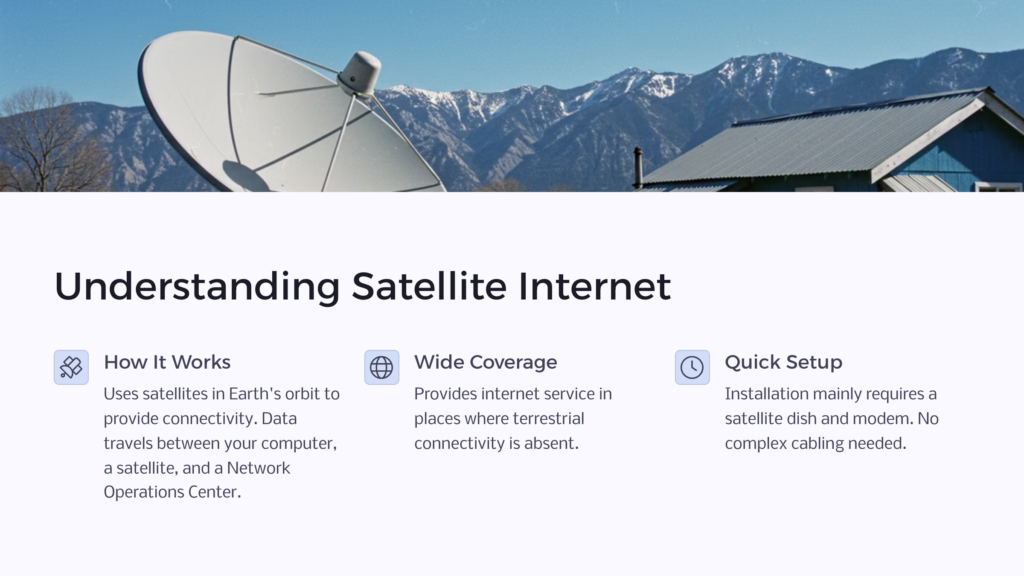Satellite Internet vs Fiber Internet: Navigating the Digital Landscape
The Internet has become a staple of modern life, central to the ways we connect and engage with the world. It’s the fulcrum with which we consume media, communicate, and even conduct business. Key to this digital landscape are the technologies that bear the mantle of connectivity, two of which are Satellite Internet and Fiber Internet.
Satellite Internet connection uses telecommunications satellites in Earth’s orbit to provide broadband connectivity. This enables users to access the internet from anywhere in the world, even remote or rural locations. Fiber Internet, in contrast, relies on fiber optic cables that use light to transmit data at incredibly high speeds.
In today’s hyper-connected world, understanding these two forms of connectivity is critical for businesses and consumers alike. This article will delve into the technical workings, advantages, disadvantages, ideal scenarios, and future prospects of both technology types.
Understanding Satellite Internet

Satellite internet involves three key components: the user’s computer, a satellite in space, and a provider’s Network Operations Center (NOC). The computer sends data requests to the satellite, which relays them to the NOC. The NOC then sends the requested data back to the user through the same route.
Advantages of Satellite Internet include:
- Geographical coverage: It provides internet service in places where terrestrial connectivity is absent.
- Quick setup: Installation mainly requires a satellite dish and modem, bypassing the need for complex cabling.
However, Satellite Internet comes with certain drawbacks:
- Latency issues: The tremendous distance data must travel results in noticeable delay or lag.
- Weather-dependent: Severe weather conditions can impair connectivity.
Satellite Internet shines in providing connectivity in remote, rural, or underserved regions. It also serves as a useful backup connectivity option when primary connections fail.
Understanding Fiber Optic Internet

Fiber Internet operates using thin strands of glass or plastic known as fiber optic cables. These cables transmit data as pulses of light. This fiber optic technology is typically implemented into a network in two ways: Fiber to the Home (FTTH), where the fiber reaches the user’s premises, or Fiber to the Node (FTTN), where fiber reaches a specific point near the user, and traditional copper cables complete the connection.
Fiber Internet has several advantages:
- High speed: Fiber can support high-speed internet, with potential speeds up to 1,000 Mbps.
- Reliability: Fiber is resistant to many of the issues that can affect other types of connections, like electronic interference.
Though superior in quality, Fiber Internet also has its share of disadvantages:
- Limited availability: Fiber optic infrastructure is costly and time-consuming to build, limiting its reach.
- Cost: Due to the high setup cost, Fiber optic internet is often more expensive than other connection types.
A fiber optic network proves ideal for uses that demand higher speeds and lower latency, such as streaming high-definition video or online gaming. It’s also beneficial for businesses that require reliable, high-speed connections for their operations.
In-depth comparison: Satellite Internet vs. Fiber Internet

Speed and Reliability: While both provide reliable connections, Fiber scores higher with speeds up to 1,000 Mbps versus Satellite’s typically 25 Mbps, and lower latency attributed to data traveling at the speed of light via fiber-optic cables.
Installation and Availability: Satellite has an edge in availability, reaching places that fiber networks have yet to penetrate. However, Fiber’s installation, though potentially more intrusive, ensures a more stable and future-proof setup.
Cost Difference and Value for Money: Satellite Internet may seem cheaper initially but may involve additional costs like equipment leasing. A fiber optic network, with its high speed and reliability, often provides more bang for the buck for internet users who can access and afford it.
Long-term Sustainability and Advancements: Fiber Internet is a sturdier and more scalable option, staying abreast with growing data demands. However, satellite internet is continuously evolving, with emerging technologies aimed at increasing speed and reducing latency.
Future changes and improvements

Satellite Internet is undergoing transformative changes. Companies such as SpaceX and OneWeb are launching Low Earth Orbit (LEO) satellites that promise higher speeds and lower latency by orbiting closer to Earth.
Fiber optic technology is likely to experience improvements in the amplification of light signals, further enhancing speed and reducing signal loss. Higher usage could also drive down costs as infrastructure development becomes more widespread.
These upcoming changes might tighten the competition as Satellite Internet speeds could rival lower-tier Fiber plans while expanded Fiber networks might penetrate rural and remote areas.
Choosing between Satellite and Fiber Internet often boils down to availability, speed requirements, and budget constraints. Satellite Internet is key where other connections fall short, offering reach and convenience. Fiber Internet is a high-speed powerhouse, excellent for demanding applications provided its access and cost are feasible.
FAQ Section
- Is Satellite Internet affected by weather?
- Yes, Satellite Internet performance may degrade during severe weather due to the signal needing to pass through the atmosphere.
- Can Fiber Internet provide service during power outages?
- Fiber Internet requires power to function; hence during power outages, unless backed by a power supply unit, Fiber Internet may go down.
- Does Fiber Internet offer better value for money than Satellite Internet?
- While more expensive, Fiber Internet’s superior speed, consistency, and capacity can offer better value for internet users with higher demands and budget flexibility.
By understanding the fundamentals, benefits, drawbacks, and ideal use-cases of Satellite and Fiber Internet, users can make informed decisions for an interconnected future. Read more and check us out at Homeowner.org for more information to help with all your home-based decisions. We’re here to help!
